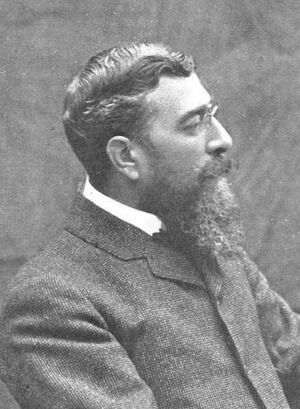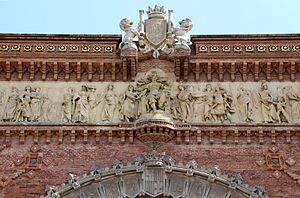Josep Reynés facts for kids
Josep Reynés i Gurguí (born in 1850 in Barcelona, Spain, and died there on June 4, 1926) was a talented Spanish sculptor. He mostly created art for inside buildings, like homes and public spaces. He also made beautiful sculptures for churches and monuments for graves.
Contents
Early Life and Training
Josep Reynés started learning about art at the Escola de la Llotja in Barcelona. He studied with two famous sculptors, the brothers Agapit and Venanci Vallmitjana. After his studies in Spain, he traveled to Paris, France, from 1873 to 1876. There, he worked in the workshops of another well-known sculptor, Jean-Baptiste Carpeaux. This experience helped him develop his unique artistic style.
Famous Works and Projects
Reynés's first big project was in 1888. He was part of a team of artists who decorated the "Arc de Triomf" in Barcelona. This was a huge arch built for the Barcelona Universal Exposition. He created a special carving, called a relief, on the main part of the arch. This carving showed "Barcelona Welcomes the Nations."
In 1890, Josep Reynés won a top award at the National Exhibition of Fine Arts in Madrid. He won for his sculpture called La Violinista (The Violinist).
One of his most famous works was made in 1893. It's the Font dels Nens (Children's Fountain) located in the beautiful Parc de la Ciutadella in Barcelona.
Monuments and Memorials
Reynés also created important monuments. In 1898, he made a monument to the famous painter El Greco in Sitges. This monument was designed in the Catalan Modernist style, which was very popular at the time.
Later, in 1907, he returned to Sitges to create another monument. This one honored Bartomeu Robert, often called "Doctor Robert." Doctor Robert had been the Mayor of Barcelona in 1899.
Cemetery Sculptures
Josep Reynés made many sculptures for the Montjuïc Cemetery in Barcelona. These works often had deep meanings. For example, he created a figure representing religion for the Salvador Bonaplata Pantheon in 1886. He also sculpted figures showing Faith and Hope for the Carles Godó Pantheon in 1899. In the Gener-Seycher Pantheon, he made female sculptures for the neo-gothic chapel between 1902 and 1906.
Architectural Decorations
In 1915, Reynés added decorative busts to the front of the Palau del Parlament de Catalunya (Parliament of Catalonia building). These busts honored important artists like Manuel Tramulles and Antoni Viladomat.
You can see some of Josep Reynés's sculptures at the Museu Nacional d'Art de Catalunya in Barcelona. His brother, Antoni Reynés, was also an artist, known for painting landscapes and flowers.
See also
 In Spanish: Josep Reynés para niños
In Spanish: Josep Reynés para niños



